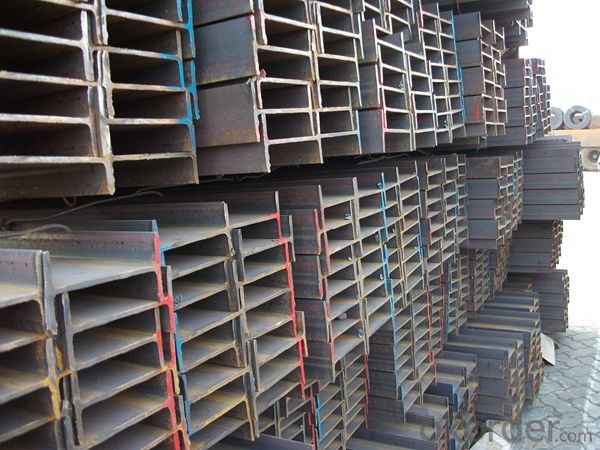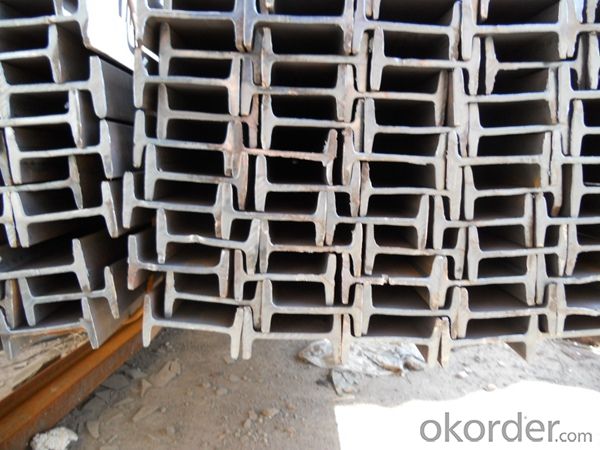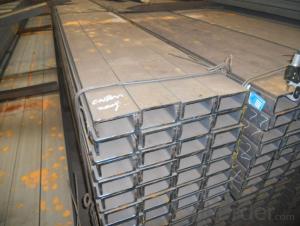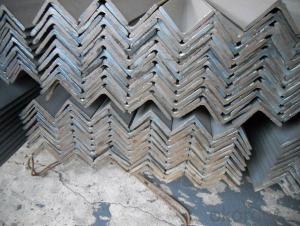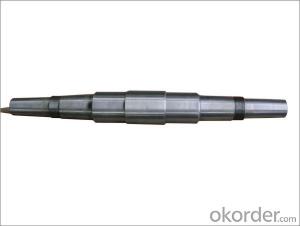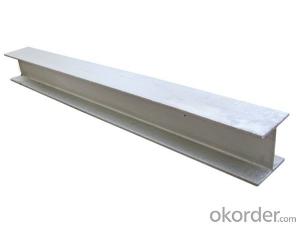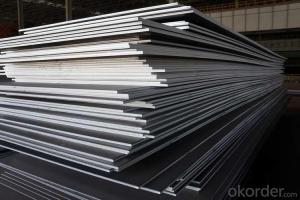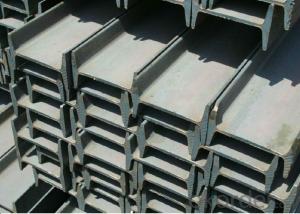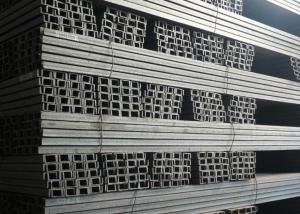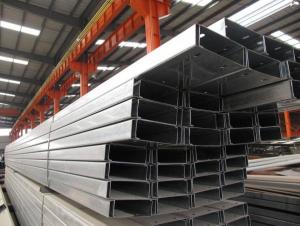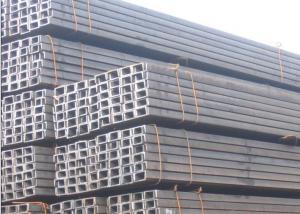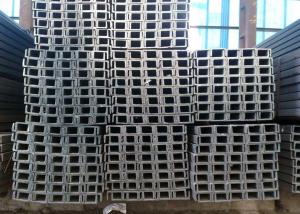Hot Rolled Mild EN Standard I Beams for Structure Construction
- Loading Port:
- Tianjin
- Payment Terms:
- TT or LC
- Min Order Qty:
- 25 m.t.
- Supply Capability:
- 200000 m.t./month
OKorder Service Pledge
OKorder Financial Service
You Might Also Like
Product Description:
OKorder is offering Hot Rolled Mild EN Standard I Beams for Structure Construction at great prices with worldwide shipping. Our supplier is a world-class manufacturer of steel, with our products utilized the world over. OKorder annually supplies products to European, North American and Asian markets. We provide quotations within 24 hours of receiving an inquiry and guarantee competitive prices.
Product Applications:
Hot Rolled Mild EN Standard I Beams for Structure Construction are ideal for structural applications and are widely used in the construction of buildings and bridges, and the manufacturing, petrochemical, and transportation industries.
1. Supporting members, most commonly in the house raising industry to strengthen timber bears under houses. Transmission line towers, etc
2. Prefabricated structure
3. Medium scale bridges
4. It is widely used in various building structures and engineering structures such as roof beams, bridges, transmission towers, hoisting machinery and transport machinery, ships, industrial furnaces, reaction tower, container frame and warehouse etc.
Product Advantages:
OKorder's Hot Rolled Mild EN Standard I Beams for Structure Construction are durable, strong, and resist corrosion. And they are made of high quality of steel billets of China.
Main Product Features:
· Premium quality
· Prompt delivery & seaworthy packing (30 days after receiving deposit)
· Corrosion resistance
· Can be recycled and reused
· Mill test certification
· Professional Service
· Competitive pricing
Product Specifications:
1. Product name: Hot Rolled Mild EN Standard I Beams for Structure Construction
2. Standard: EN10025, GB Standard, ASTM, JIS etc.
3. Grade: Q235B, A36, S235JR, Q345, SS400 or other equivalent.
4. Length: 5.8M, 6M, 9M, 10M, 12M or as your requirements
Section | Standard Sectional Dimensions(mm) | ||||
h | b | s | t | Mass Kg/m | |
IPE80 | 80 | 46 | 3.80 | 5.20 | 6.00 |
IPE100 | 100 | 55 | 4.10 | 5.70 | 8.10 |
IPE120 | 120 | 64 | 4.80 | 6.30 | 10.40 |
IPE140 | 140 | 73 | 4.70 | 6.90 | 12.90 |
IPE160 | 160 | 82 | 5.00 | 7.40 | 15.80 |
IPE180 | 180 | 91 | 5.30 | 8.00 | 18.80 |
IPE200 | 200 | 100 | 5.60 | 8.50 | 22.40 |
IPE220 | 220 | 110 | 5.90 | 9.20 | 26.20 |
IPE240 | 240 | 120 | 6.20 | 9.80 | 30.70 |
IPE270 | 270 | 135 | 6.60 | 10.20 | 36.10 |
IPEAA80 | 80 | 46 | 3.20 | 4.20 | 4.95 |
IPEAA100 | 100 | 55 | 3.60 | 4.50 | 6.72 |
IPEAA120 | 120 | 64 | 3.80 | 4.80 | 8.36 |
IPEAA140 | 140 | 73 | 3.80 | 5.20 | 10.05 |
IPEAA160 | 160 | 82 | 4.00 | 5.60 | 12.31 |
IPEAA180 | 180 | 91 | 4.30 | 6.50 | 15.40 |
IPEAA200 | 200 | 100 | 4.50 | 6.70 | 17.95 |
FAQ:
Q1: Why buy Hot Rolled Mild EN Standard I Beams for Structure Construction from OKorder.com?
A1: All Hot Rolled Mild EN Standard I Beams for Structure Construction offered byOKorder.com are carefully selected from China's most reliable manufacturing enterprises. Through its ISO certifications, OKorder.com adheres to the highest standards and a commitment to supply chain safety and customer satisfaction.
Q2: How do we guarantee the quality of our Hot Rolled Mild EN Standard I Beams for Structure Construction?
A2: We have established an advanced quality management system which conducts strict quality tests at every step, from raw materials to the final product. At the same time, we provide extensive follow-up service assurances as required.
Q3: How soon can we receive the Hot Rolled Mild EN Standard I Beams for Structure Construction after purchase?
A3: Within three days of placing an order, we will begin production. The specific shipping date is dependent upon international and government factors, but is typically 7 to 10 workdays.
Q5: Can Hot Rolled Mild EN Standard I Beams for Structure Construction rust?
A5: Stainless does not "rust" as you think of regular steel rusting with a red oxide on the surface that flakes off. If you see red rust it is probably due to some iron particles that have contaminated the surface of the stainless steel and it is these iron particles that are rusting. Look at the source of the rusting and see if you can remove it from the surface.
Images:

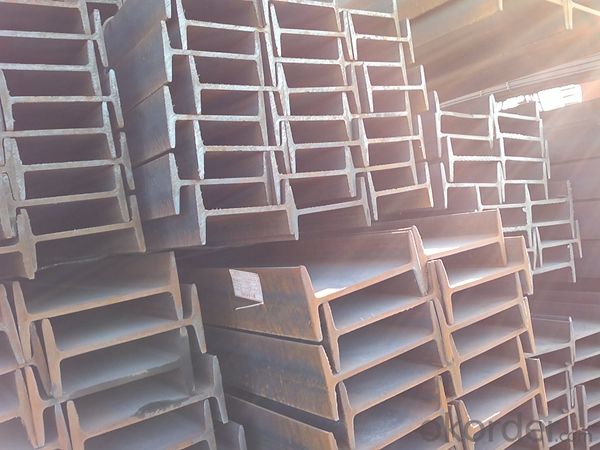
- Q: How do steel channels compare to other structural materials?
- Steel channels have many advantages compared to other structural materials. Firstly, steel channels are incredibly strong and have a high load-bearing capacity. They can withstand heavy loads and provide excellent structural support, making them suitable for a wide range of applications such as bridges, buildings, and infrastructure projects. Additionally, steel channels are highly durable and have a long lifespan. They are resistant to corrosion, rust, and degradation, which ensures that they can withstand harsh environmental conditions and maintain their integrity over time. This durability makes steel channels a cost-effective choice as they require minimal maintenance and replacement. Steel channels also offer design versatility. They can be easily fabricated and customized to meet specific project requirements. They can be cut, drilled, and shaped into various sizes and lengths, allowing for flexibility in design and construction. This adaptability makes steel channels suitable for both simple and complex structural applications. Moreover, steel channels have excellent fire resistance properties. They can withstand high temperatures for a longer duration compared to other materials like wood or aluminum. This makes them a safer choice for buildings and structures, as they provide additional time for evacuation and minimize the risk of collapse during a fire. Lastly, steel channels are environmentally friendly. They are made from recycled materials and can be recycled at the end of their lifespan, reducing the demand for raw materials and minimizing waste. This sustainability aspect makes steel channels a preferred choice for eco-conscious construction projects. Overall, steel channels are superior to other structural materials due to their strength, durability, design versatility, fire resistance, and environmental sustainability. Their numerous advantages make them a reliable and efficient choice for various construction applications.
- Q: Can steel channels be used in the telecommunications manufacturing industry?
- Yes, steel channels can be used in the telecommunications manufacturing industry. Steel channels are commonly used in various industries, including telecommunications, due to their strength, durability, and versatility. In the telecommunications industry, steel channels can be used for various applications such as cable trays, support structures for antennas and satellite dishes, equipment racks, and enclosures. Steel channels provide a robust and reliable solution to support and protect telecommunications equipment and infrastructure. Additionally, steel channels can be easily fabricated and customized to meet specific requirements, making them suitable for the diverse needs of the telecommunications manufacturing industry.
- Q: What are the different types of steel channel supports?
- In construction and engineering projects, various types of steel channel supports are commonly utilized to ensure structural stability and support. These supports serve different purposes and can be categorized as follows: 1. C-Channel Supports: These supports possess exceptional strength and rigidity due to their "C" shape. They are frequently employed in industrial settings to bear the weight of heavy equipment and machinery. 2. U-Channel Supports: Similar to C-channel supports, U-channel supports are shaped like a "U" and offer versatility. They can be used for framing and bracing structures in a wide range of applications. 3. Back-to-Back Channel Supports: Comprising two parallel channels welded together, these supports provide enhanced strength and stability. They are commonly employed in applications that require additional load-bearing capacity. 4. Slotted Channel Supports: These supports feature slots along the length of the channel, enabling easy adjustment and flexibility. They find utility in applications where the position of the support needs to be altered. 5. Strut Channel Supports: Also known as strut or framing channel supports, these supports are designed with specialized channels that facilitate the attachment of fittings and accessories. They are frequently utilized in electrical and mechanical installations. 6. Adjustable Channel Supports: These supports incorporate telescoping or adjustable sections for height and width adjustment. They are commonly used in applications that demand adaptability to changing requirements. 7. Stainless Steel Channel Supports: Manufactured from corrosion-resistant stainless steel, these supports are ideal for use in harsh or corrosive environments. These examples represent only a fraction of the available types of steel channel supports. Each type offers distinct features and benefits, enabling their utilization in various industries. The choice of support depends on the specific requirements of the project and the necessary load-bearing capacity.
- Q: What are the different types of steel channel connections for floor framing?
- For floor framing, there exist various types of connections for steel channels. 1. Welded Connections: The most commonly used connection for steel channel floor framing is welding. This involves welding the channels at the joints, resulting in a robust and long-lasting connection. Welded connections are suitable for heavy loads and high levels of vibration. 2. Bolted Connections: Another option is using bolts to connect the channels. This type of connection allows for easy disassembly and reassembly, making it ideal for situations where modifications or relocation may be necessary. Bolted connections are also more cost-effective than welded connections and can handle lighter loads. 3. Riveted Connections: Riveted connections involve using rivets instead of bolts to connect the channels. This type of connection offers a strong and secure bond and is often preferred for its traditional or aesthetic appearance. 4. Clip Connections: Clip connections involve using clips or brackets to hold the channels together. This type of connection is quick and easy to install and does not require welding or drilling. Clip connections are commonly used when quick assembly or potential future disassembly is desired. 5. Moment Connections: Moment connections are suitable when the channels need to resist bending moments or torsion. These connections provide a rigid bond between the channels, enabling effective load transfer. Moment connections are more complex and require meticulous design and installation. In summary, the choice of steel channel connection for floor framing depends on factors such as load requirements, project specifications, and budget. It is advisable to seek guidance from a structural engineer or professional to determine the most suitable connection type for your specific application.
- Q: If there is a cylinder, the diameter is about 1000mm, height is about 1000mm, similar to the kind of pressure vessel, plate thickness 6mm 304 of stainless steel, want to use 4 channel steel leg support, how big is appropriate? How do you calculate it?
- What's in the pressure vessel?Calculate the weight, each channel bear 1/4, calculate the required area of A=N/p, and then channel selection.Very simple buddy.
- Q: How do steel channels contribute to the overall sustainability of a construction project?
- There are several ways in which steel channels contribute to the overall sustainability of a construction project. To begin with, they are manufactured using recycled materials, which reduces the demand for new resources and lessens the environmental impact of mining and processing raw materials. This helps conserve natural resources and reduces the energy needed for production, making steel channels a more sustainable choice. In addition, steel channels have a lengthy lifespan and require minimal maintenance. They are highly durable and resistant to corrosion, enabling them to withstand harsh weather conditions and endure for many years without needing replacement or frequent repairs. This reduces the overall use of materials and generation of waste, making the construction project more sustainable in the long term. Moreover, steel channels are lightweight and easy to transport. This decreases energy consumption and greenhouse gas emissions related to transportation, as less fuel is needed to move them from the manufacturing facility to the construction site. Furthermore, their lightweight nature makes them easier to handle and install, reducing the necessity for heavy machinery and the associated energy consumption during the construction process. Lastly, steel channels can be easily recycled at the end of their lifespan. Unlike other construction materials, steel can be melted down and reused multiple times without losing its properties. This not only reduces the amount of waste sent to landfills but also diminishes the need for new steel production, further conserving natural resources and decreasing environmental impact. To conclude, steel channels contribute to the overall sustainability of a construction project through their use of recycled materials, long lifespan, lightweight and easy transportability, and recyclability at the end of their life. By incorporating steel channels into construction projects, we can reduce environmental impact, conserve natural resources, and promote a more sustainable built environment.
- Q: What are the cost considerations of using steel channels?
- When using steel channels, there are various factors to consider in terms of cost. The first major factor is the price of the steel material itself. This cost can fluctuate depending on market conditions and availability, so it is important to take these variables into account when estimating the overall cost. Another consideration is the fabrication process. To meet specific project requirements, steel channels often need cutting, welding, and shaping. The cost of these processes, including labor, equipment, and materials, should be factored into the project budget. Transportation and shipping costs can also contribute to the total cost of using steel channels. Because steel is heavy and bulky, transporting it from the manufacturing facility to the construction site can be expensive, especially if long distances are involved. Furthermore, the installation process should be considered when evaluating the cost. Depending on the complexity of the project, specialized equipment or expertise may be necessary for proper installation. These additional costs should be taken into account when estimating the overall budget. Lastly, it is important to consider the long-term costs associated with steel channels. Steel is known for its durability and longevity, which can result in lower maintenance and replacement costs over time. However, factors such as corrosion protection and regular inspections should be considered to ensure the longevity of steel channels and prevent unexpected expenses in the future. To summarize, the cost considerations of using steel channels include the price of the steel material, the fabrication process, transportation and shipping, installation, and long-term maintenance. By carefully considering these factors and conducting a thorough cost analysis, informed decisions can be made regarding the use of steel channels in construction projects.
- Q: Are steel channels suitable for DIY projects?
- For DIY projects, steel channels are a suitable option. With their versatility and sturdiness, steel channels are ideal for a range of DIY applications. You can utilize them to construct shelves, workbenches, frames, and supports for different structures. By using steel channels, you can ensure that your DIY project will be strong and long-lasting because of their excellent strength and durability. Moreover, steel channels are easily obtainable in various sizes and lengths, making it effortless to find the right dimensions for your project. Additionally, they are relatively easy to work with, allowing DIY enthusiasts to cut, drill, and weld them as necessary. All things considered, steel channels are an excellent choice for DIY projects, thanks to their strength, versatility, and availability.
- Q: Channel 10, 6 meters long, two ends fixed, how much weight can the middle bear?
- It's important to see where you've used it. If you allow it to bend, you'll have to bear a lot of weight, but vice versa
- Q: Can steel channels be used for decorative purposes?
- Yes, steel channels can be used for decorative purposes. They can be used to create a modern and industrial look in interior design, such as in furniture, staircases, or room dividers. Additionally, steel channels can be used as decorative trim or accents in architectural projects, adding a sleek and contemporary touch to the overall design.
Send your message to us
Hot Rolled Mild EN Standard I Beams for Structure Construction
- Loading Port:
- Tianjin
- Payment Terms:
- TT or LC
- Min Order Qty:
- 25 m.t.
- Supply Capability:
- 200000 m.t./month
OKorder Service Pledge
OKorder Financial Service
Similar products
Hot products
Hot Searches
Related keywords




